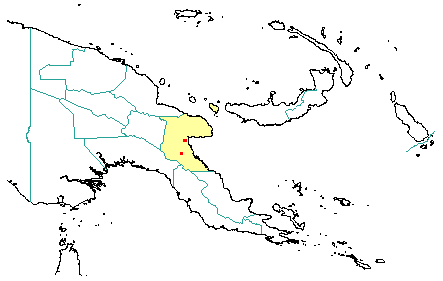
in PNGplants database
PNGTreesKey – Xanthomyrtus angustifolia A.J.Scott |
Barry Conn (NSW) & Kipiro Damas (LAE).
Guide to trees of Papua New Guinea
Copyright held by the authors, National Herbarium of New South Wales, and Papua New Guinea National Herbarium
Kew Bulletin Vol. Vol. 33 Part. 3: 466 (1979)
Family: Myrtaceae
Dicotyledon
Timber Group: Non-timber species
Field Characters: Small sub-canopy tree (up to c. 20 m high) or Large canopy tree (up to 30 m high); Bole cylindrical (to slightly spurred at base, up to c. 45 cm diam.); straight (mostly bole up to c. 7 m long); buttresses buttresses absent; spines spines absent; aerial roots aerial roots absent; stilt roots stilt roots absent; Bark red or brown, rough, scaly or flaky or fissured; Subrhytidome (under-bark) brown or red; less than 25 mm thick, 3.0-6.0; bark blaze consisting of one layer; faintly to non-aromatic; outer blaze yellow or brown, markings absent, fibrous; inner blaze yellow or brown, markings absent, fibrous; bark exudate (sap) present (very slightly) or absent, colourless, not readily flowing (spotty), colour not changing on exposure to air, not sticky; terminal buds not enclosed by leaves.
Indumentum: Complex hairs absent; stinging hairs absent; mature twig indumentum (hairs) present when young or absent, hairs dense to sparse.
Leaves: Leaves spaced along branches, opposite (in pairs, opposite one another on the branchlet) (to sub-opposite), simple (a leaf composed of a single blade); petiole present (short), not winged, attached to base of leaf blade, not swollen; leaves broadest below middle, (1.0-) 1.8-4.5 cm, (0.3-) 0.6-0.8 (-1.2) cm; symmetric, entire, not dissected or lobed, long-tapering (acumen up to 20 mm long), venation pinnate, secondary veins open, not prominent, but visible to not visible, intramarginal veins present (intramarginal vein running c. 1 mm from margin; lamina margin thickened); leaves lower surface pale green, upper surface green (glossy), indumentum (hairs) usually present or rarely absent, indumentum (hairs) sparse or dense; present (densely glandular); domatia absent; stipules absent.
Flowers: Inflorescence axillary, flowers on an unbranched axis (mostly up to 3-flowered), cones absent; flowers bisexual, stalked (shortly) or not stalked (almost (subsessile), flowers with many planes of symmetry, 4.0-5.0 mm long, diameter small (up to10 mm diam.) (c. 4 mm diam.); perianth present, with distinct sepals and petals whorls, inner perianth bright yellow; 4, free; stamens 25-30, present, free of each other, free of the perianth (inserted on hypanthium); ovary inferior, carpels joined (when more than one), locules 2-3; styles solitary, 1.
Fruits: Infrutescence arranged on unbranched axis, fruit 4.0-5.0 mm long, 4.0-5.0 mm diam., blue or black, not spiny, fleshy, simple, indehiscent, berry (sepals persistent); seeds 100, barely visible (to 1 mm long) (c. 1 mm long), not winged, broad (as wide as long), seed 1-10 mm diam. (c. 1 mm diam.).
Distribution: Morobe.
 | Botanical records in PNGplants database |
Notes: Notes Morphologically Xanthomyrtus angustifolia is very similar to Xanthomyrtus polyclada. Both species are large trees, with X. angustifolia apparently have leaves with shorter leaf apices (acumen) (5-8 mm long) compared to 4-13 mm long in X. polyclada. However, the type material of X. angustifolia (J.J. Havel NGF17271) has leaf acumen 8- c. 13 mm long. A.J. Scott, in Kew Bulletin, Volume 33: pp. 461-484 (1978) states that X. angustifolia has smaller flowers (with calyx lobes 1 mm long and 1 mm wide at base; stamens 3 mm long) than X. polyclada (calyx lobes 1.5-2 mm long and 1-1.5 mm wide at base; stamens 4-6 mm long). Recent collections from the Wagau region (Morobe region) (namely, B.J. Conn 5046 et al. and O. Paul et al. LAE87520) have small flowers comparable with those of X. angustifolia, but has long-tapering leaves (acumen 12-20 mm long) more similar to those of X. polyclada. These collections have flowers with the outer surface of the calyx (tube and lobes) densely hairy (hairs whitish grey), whereas A.J. Scott (1978) describes the calyx tube of X. angustifolia as being hairy and calyx lobes with the outer surface glabrous. These collections were gathered from trees that were about 30 m high, larger than the 'up to 20 m high' cited by Scott (1978) for X. angustifolia. The taxonomic distinctness of X. angustifolia from X. polyclada is unclear. These two recent collections have been tentatively identified as X. angustifolia.